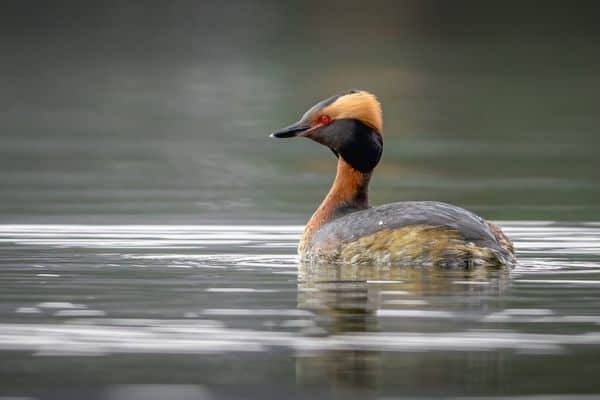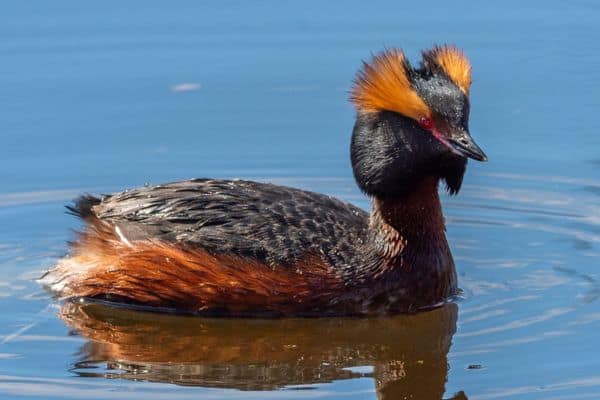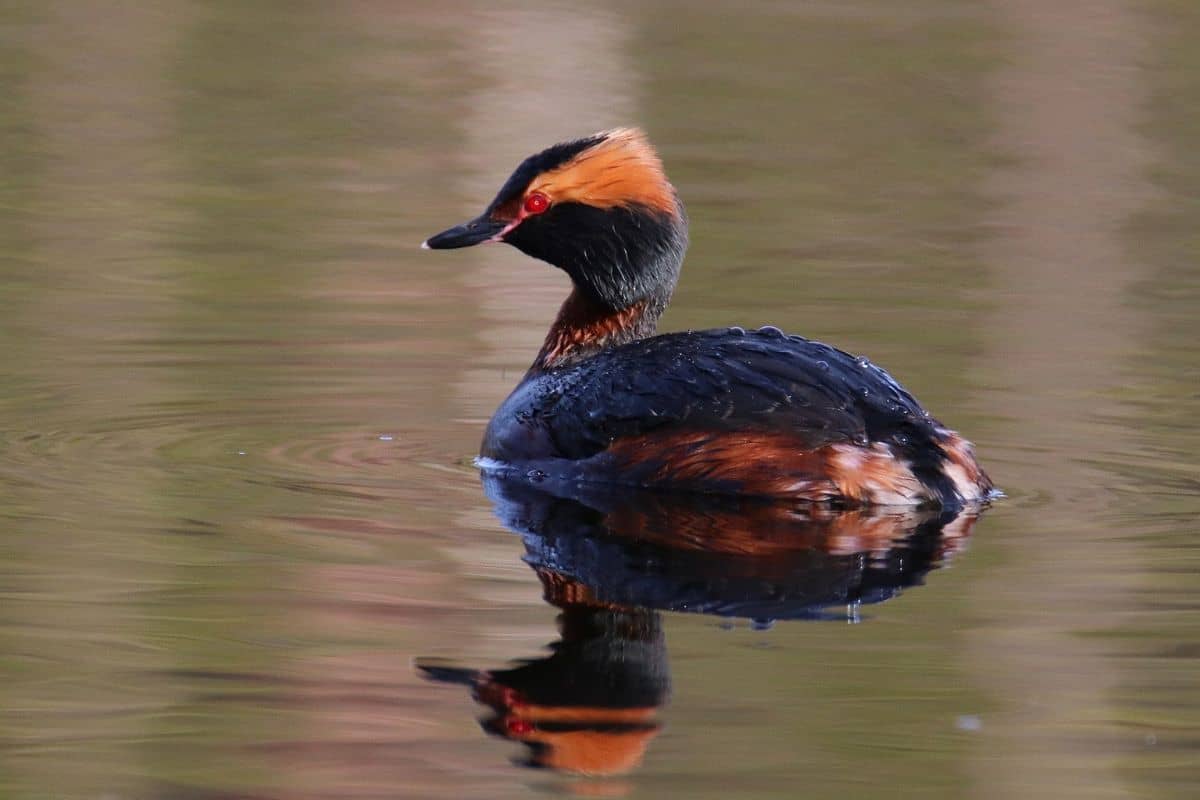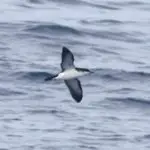Common Name: Horned Grebe
Scientific Name: Podiceps auritus| Size | Diet | Range in Hawaii | Status in Hawaii |
|---|---|---|---|
| 12 in. - 15 in. | fish, crustaceans, and aquatic insects. | Unknown | Vulnerable |
The Horned Grebe, also known as the Slavonian Grebe, is a small waterbird that is known for its striking appearance and unique behaviors. With its gray-black head and back, brick red neck, and blazing yellow-orange “horns” on its head, the Horned Grebe is a sight to behold during the summer months.
While the Horned Grebe is not a resident of Hawaii, individuals have been reported on several of the islands as rare vagrants. In this article, we’ll explore the fascinating world of the Horned Grebe, from its habitat and diet to its unique breeding behaviors and conservation status.
Horned Grebe
Appearance

The Horned Grebe is a relatively small waterbird, measuring between 12 and 15 inches long and weighing 10 and 20 ounces. It has a distinctive appearance, with a gray-black head and back, brick red neck, and blazing yellow-orange “horns” on its head during the breeding season. The Horned Grebe also has a sharp, pointed bill that is black in color.
During winter, the Horned Grebe transitions to a much more subdued gray and white coloration, with a neat black cap and white cheek that helps separate it from the similar Eared Grebe. Both male and female Horned Grebes have similar plumage, although males are slightly larger and more brightly colored than females.
Diet
The Horned Grebe is primarily a carnivorous bird, feeding on a variety of aquatic creatures such as fish, crustaceans, and aquatic insects. During the breeding season, Horned Grebes may also eat tadpoles, leeches, and small amounts of plant material.
The diet of Horned Grebes varies with habitat and season, with aquatic arthropods being the main food source during the summer months and fish and crustaceans being the primary food source during the winter months. Horned Grebes are well adapted for diving and swimming underwater, and are able to catch prey using their sharp, pointed bills and strong legs.
Nesting
Horned Grebes typically build their nests on floating mats of aquatic vegetation in shallow water. The nests are made of plant material such as cattails, reeds, and sedges, and are often anchored to emergent vegetation or the bottom of the pond.
The nests are usually built by both the male and female Horned Grebe, and are a floating heap of wet plant material with a depression in the middle for the eggs. The eggs are typically laid in May or June, and both parents take turns incubating them for about 20-25 days.
After the eggs hatch, the parents continue to care for the young, feeding them small fish and aquatic invertebrates until they are able to fend for themselves.
Behavior

Horned Grebes are highly adapted to life in the water, and are excellent swimmers and divers. They use their wings and feet to propel themselves through the water, and are able to regulate their buoyancy by adjusting the amount of air in their feathers.
Horned Grebes are also able to dive and swim underwater for extended periods of time, sometimes staying submerged for up to a minute. During the breeding season, Horned Grebes become more territorial and may engage in aggressive displays to defend their nests.
These displays can include head-shaking, bill-raising, and weed-carrying. Horned Grebes are generally solitary birds, although they may form loose groups during migration or in winter. Horned Grebes are also known for their distinctive call, which sounds like a low, rolling laugh.
Habitat
The Horned Grebe is a waterbird that is found in a variety of aquatic habitats, including lakes, ponds, marshes, and coastal waters. During the breeding season, Horned Grebes typically inhabit freshwater lakes and ponds that have both open water and marsh vegetation, surrounded by northern forest, prairie, or sometimes the southern edges of tundra.
In winter, Horned Grebes may be found in a wider range of habitats, including coastal bays, estuaries, and offshore waters. Horned Grebes are generally found in areas with clear water and abundant aquatic vegetation, which provides cover and food for the birds.
The distribution of Horned Grebes is largely determined by the availability of suitable breeding habitat, which has been impacted by human activities such as forestry and agriculture.
Range
The Horned Grebe is a migratory bird that breeds in the northern parts of North America, Europe, and Asia. Although the Horned Grebe is not typically found in Hawaii, there have been rare sightings of individuals on several of the islands, indicating that they may occasionally visit the area as vagrants.
Conservation Status

Horned Grebe is listed as “Vulnerable” on the IUCN Red List. This designation indicates that the species is facing a high risk of extinction in the wild.
Threats to Horned Grebes include habitat loss and degradation, pollution, and climate change. The loss of wetland habitats, particularly those with emergent vegetation, has had a significant impact on breeding populations of Horned Grebes.
Interesting Facts
1. Excellent swimmers and divers
Horned Grebes are excellent swimmers and divers, and are able to stay submerged for up to a minute.
2. Unique courtship display
They have a unique courtship display, which involves the male and female swimming together and mirroring each other’s movements.
3. Short lifespan
They have a relatively short lifespan, with most individuals living only 3-4 years.
4. Considered an indicator species
Horned Grebes are considered an indicator species of wetland health, as they are highly dependent on healthy wetland habitats for breeding and feeding.
5. Molt their feathers twice a year
Horned Grebes are known to molt their feathers twice a year, once in the breeding season and once in the non-breeding season.
Frequently Asked Questions
1. How deep can Horned Grebes dive?
According to the Cornell Lab of Ornithology, Horned Grebes dive to depths of up to 20 feet in larger water bodies to pursue mostly small fish.
2. How do Horned Grebes communicate with each other?
Horned Grebes are known for their distinctive call, which sounds like a low, rolling laugh. They also engage in aggressive displays during the breeding season, which can include head-shaking, bill-raising, and weed-carrying.
3.What are some threats to Horned Grebes?
Horned Grebes face a variety of threats, including habitat loss, pollution, and climate change. They are also sometimes hunted for their feathers and meat.




